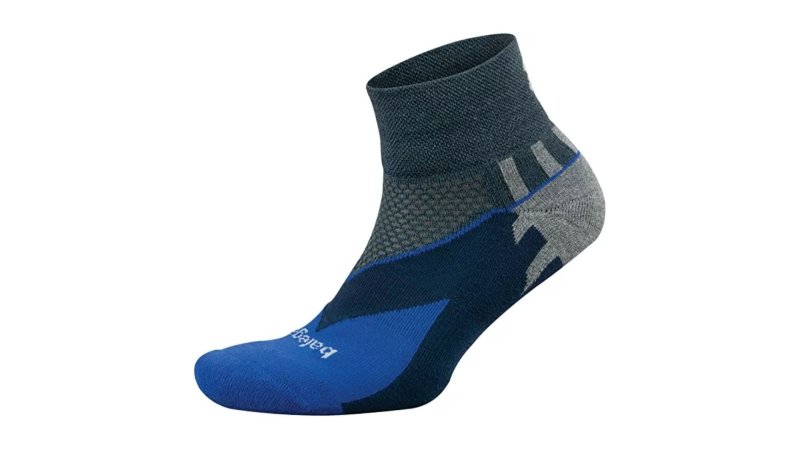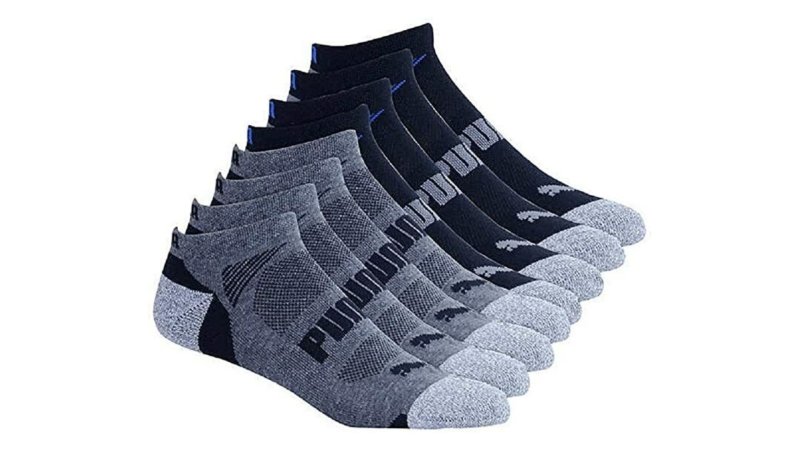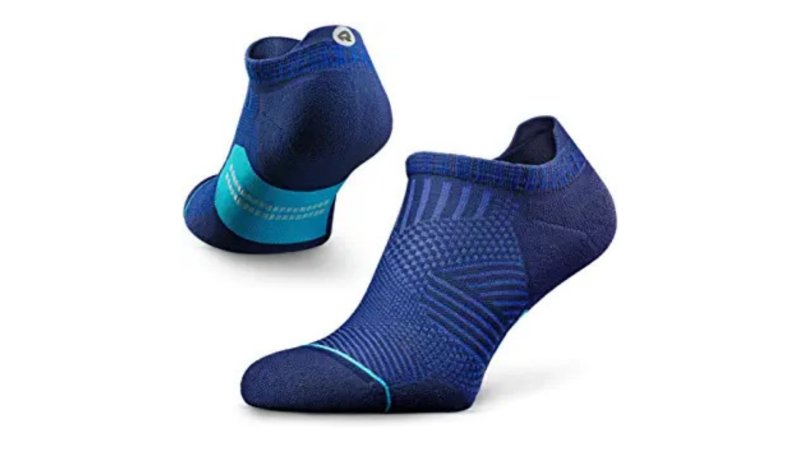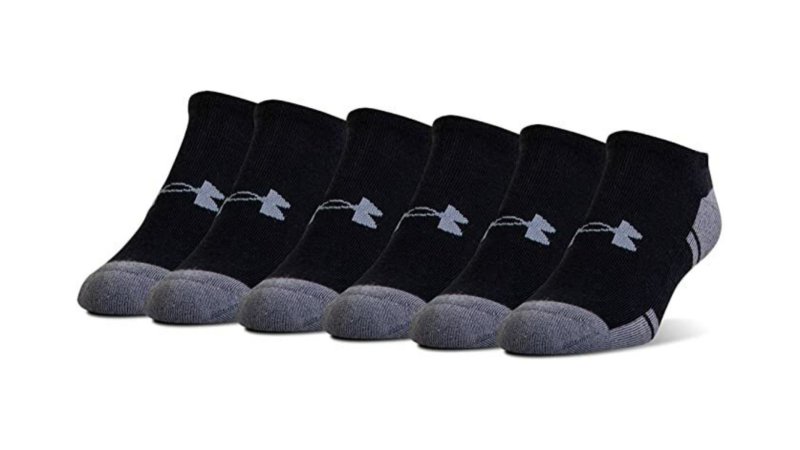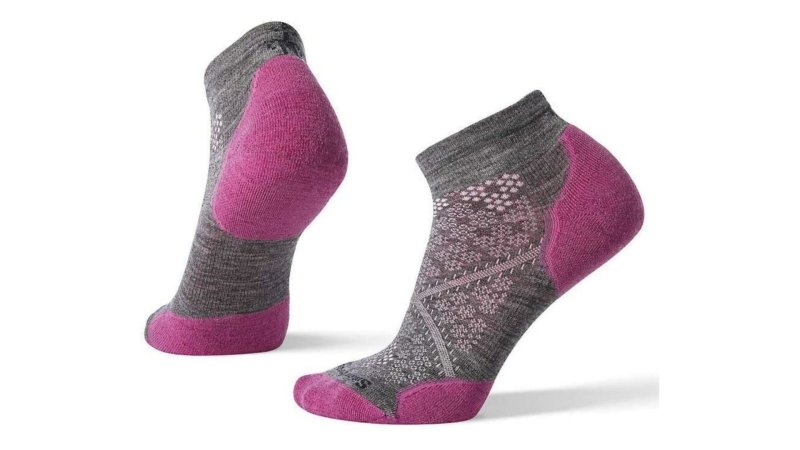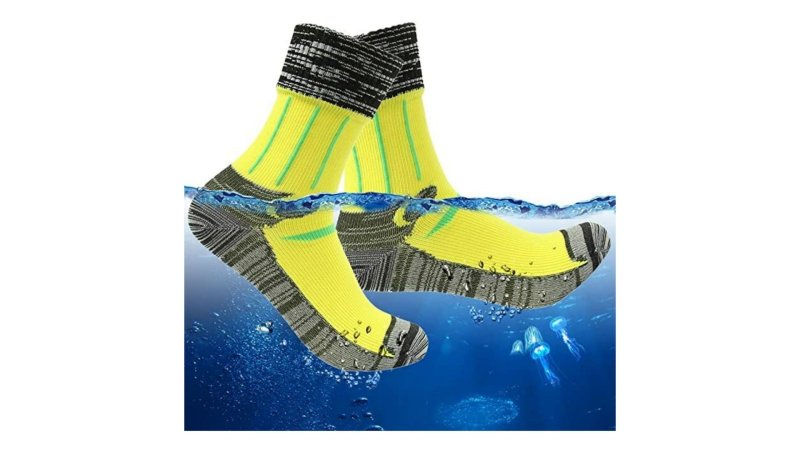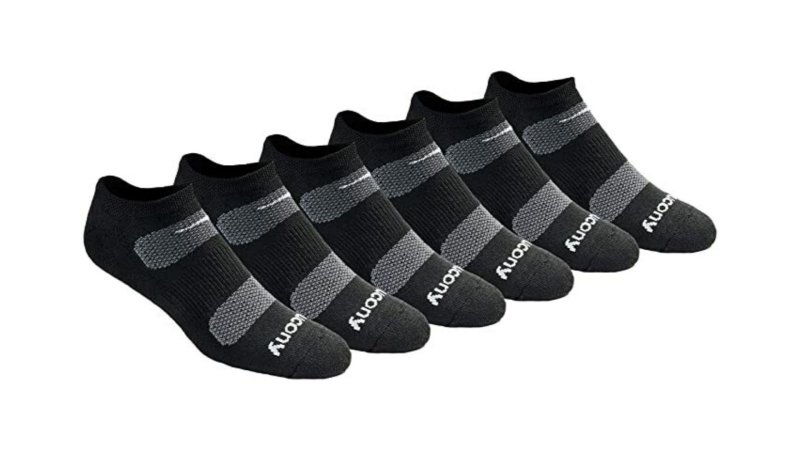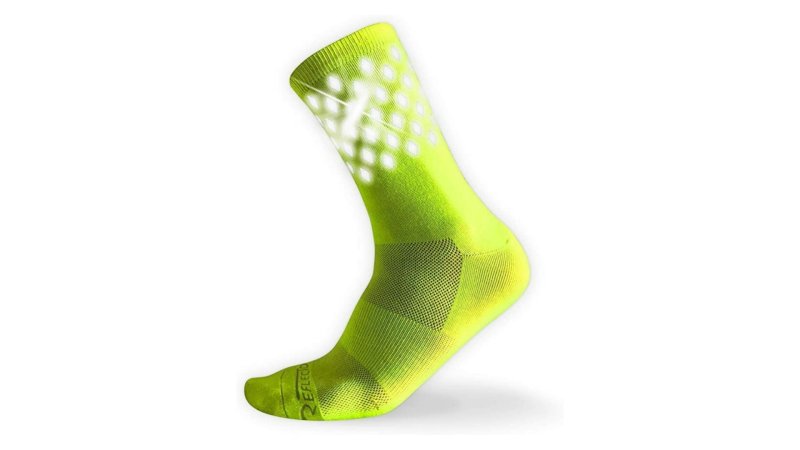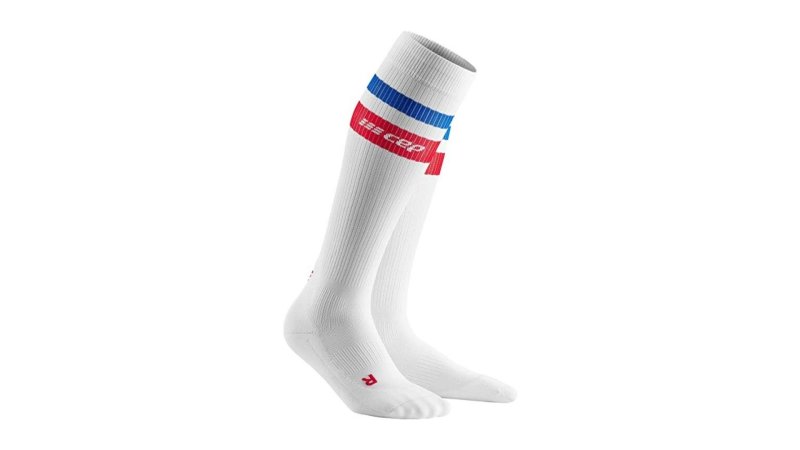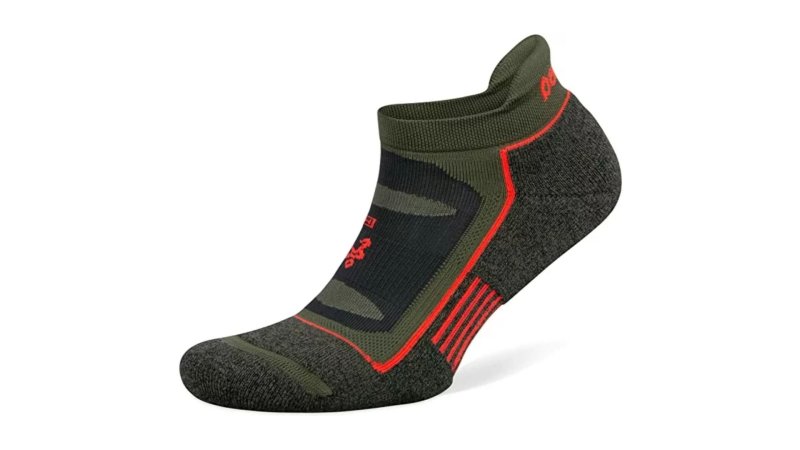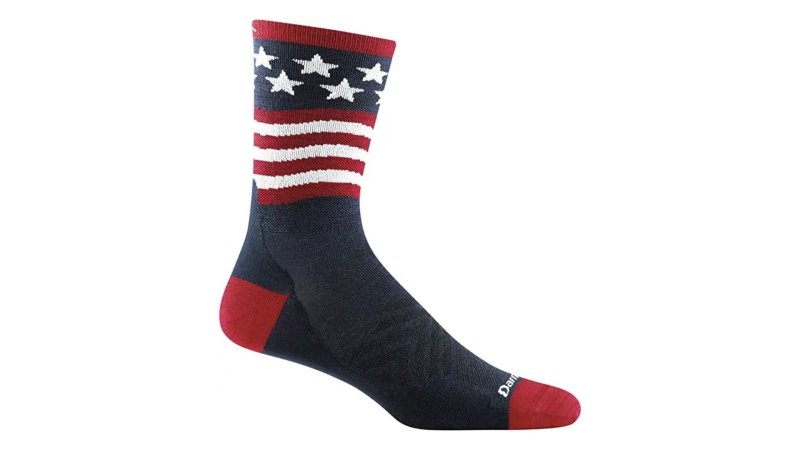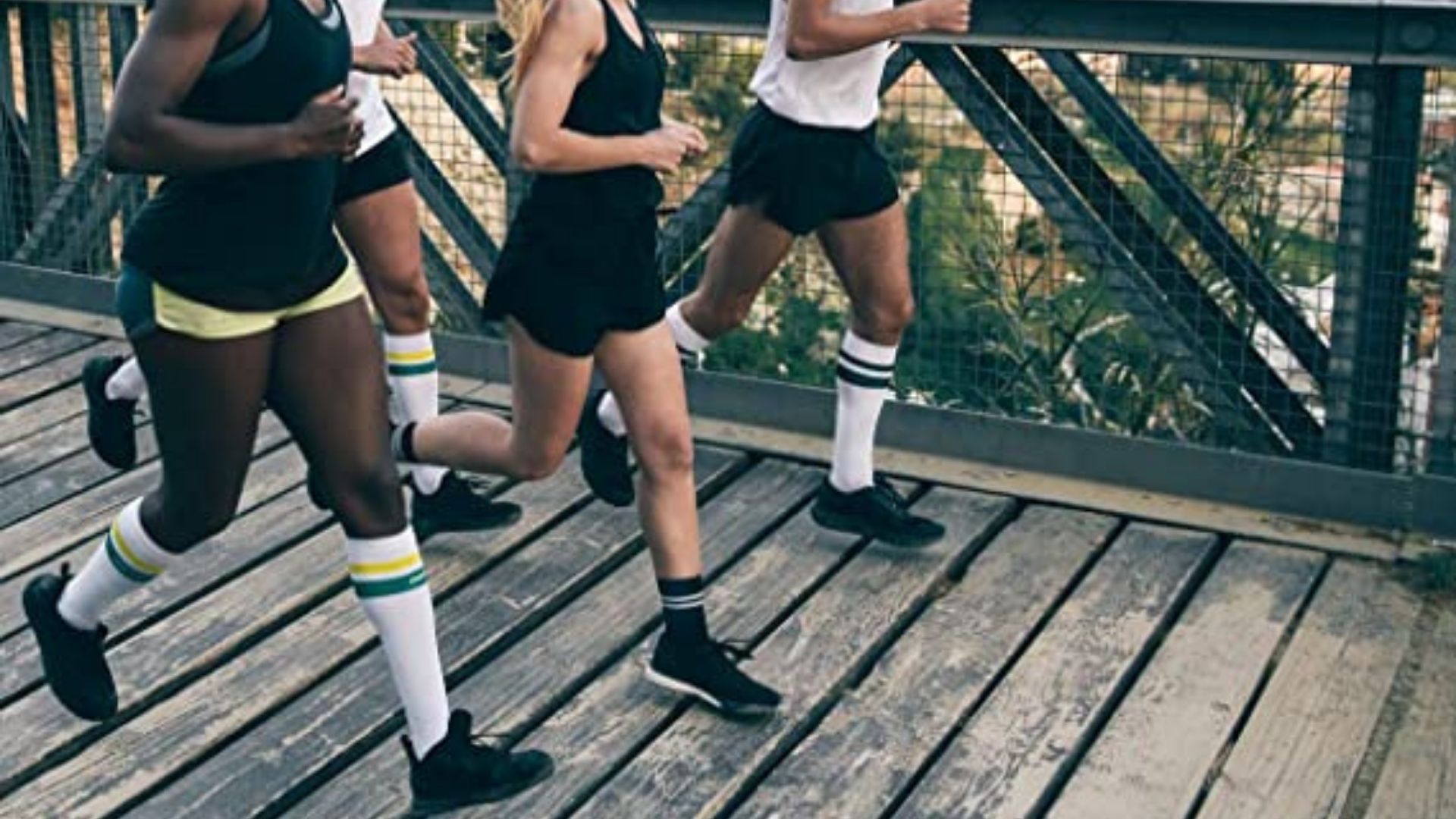

We may earn revenue from the products available on this page and participate in affiliate programs.
It’s commonly believed that the specific shoe you choose will determine your performance during any strenuous exercise, but don’t underestimate the value of running socks. It’s true, the shoe plays a huge role in comfort, and we’ve come a long way from strapping pieces of leather to our feet and calling them sandals, thankfully. But while you’re probably aware that there has been a ton of research into running shoe technology, did you know running socks are just as important? Sure, companies haven’t figured out a way to sync your sock and fitness tracker yet, but running socks are just as critical as the rest of your fitness gear. The sock acts as a barrier between your foot and the shoe, essentially a foot shield. Overlooking your sock selection could have dire consequences.
If you’ve ever gotten a blister while on a run, you know how painful it can be and how socks play a factor. If you don’t, well then you’re lucky and you’ll just have to imagine what it’s like having a hot poker rammed into your foot every time it hits the ground. Every step creates friction, and when your shoes and socks aren’t right, that friction will create blisters. David Goggins may choose to run on blistered feet, but there’s no reason you have to (unless you want to become a Navy SEAL). Instead, you can select a pair of the best running socks so that your feet have a foot shield to protect against blisters and debris.
Best Overall
Balega Enduro V-Tech Quarter Socks
Pros
- Breathable mesh panel keeps feet cool
- Seamless toe increases comfort
- Compression for extra support
- Mid-weight cushion aids in endurance/recovery
Cons
- Compression isn’t certified for medical uses
- High price point
Product Specs
- Brand Balega
- Material 75% Polyester, 23% Nylon, 2% Elastane
- Length Quarter (Ankle)
Best Value
Puma No-Show Sport Socks
Pros
- Cheap pricing, easy to replace
- Sport cushion offers multi-discipline comfort
- Mesh ventilation for extra breathability
Cons
- Cotton absorbs moisture, not ideal for wet weather
- No specialty features
- No heel tab
Product Specs
- Brand: Puma
- Material: Polyester, Cotton, Spandex
- Length: No-show
Best Recycled Material
Rockay Accelerate
Pros
- Environmentally friendly
- Medium cushion
- Designed to wick sweat away
- Built seamless to prevent chafing
Cons
- High pricing for single pair
- Arch compression not intended for medical use
Product Specs
- Brand: Rockay
- Material: 100% Recycled: Features Econyl, made from ocean waste u0026 landfill fabrics
- Length: No-show
Best for Men
Under Armour Resistor 3.0
Pros
- Multi-sport functionality
- Half cushion for comfort
- Compression around the arch increases support
- Moderate pricing
Cons
- No fancy features
- Only available in black and white
Product Specs
- Brand: Under Armour
- Material: 98% Polyester, 2% spandex
- Length: No-show
Best for Women
Smartwool PhD Run Light Elite
Pros
- Specially designed for women’s feet
- Slight compression for extreme comfort
- Durable construction
- Great for all seasons
Cons
- The light cushion may not be enough for some
- High price point for single pair
Product Specs
- Brand: Smartwool
- Material: Nylon, Merino wool, and elastane
- Length: Ankle
Best Waterproof
Randy Sun 100% Waterproof Socks
Pros
- 100% waterproof and windproof
- Material remains breathable for feet
- Seamless toe
- Satisfaction guarantee
Cons
- Premium pricing
- Special washing instructions
- Not suited for all seasons
Product Specs
- Brand: Randy Sun
- Material: Three layers include Nylon, lycra, elastane, waterproof membrane, and Coolmax.
- Length: Crew
Best Quick Drying Running Socks
Saucony Mesh Ventilating Performance No Show Socks
Pros
- Breathable mesh doesn’t suffocate feet
- Moisture wicking materials keep feet dryer
- Light cushioning for comfort
- Some compression for added support
Cons
- Compression not for medical purposes
- Not ideal in winter weather
Product Specs
- Brand: Saucony
- Material: 98% polyester, 2% spandex
- Length: No-show
Best Reflective
ReflecToes High Reflective Socks
Pros
- High-reflective material up to 50 times brighter than competition
- Moisture wicking yarns
- Slight compression offers arch support
Cons
- Moderate price point
- No cushion
Product Specs
- Brand: ReflecToes
- Material: Reflective HTL/Fabric
- Length: Crew
Best Compression
CEP Athletic Compression Socks
Pros
- Compression increases blood flow for superior performance
- Speeds up recovery and fights overuse injuries
- Tall length keeps you warm in winter
Cons
- Premium pricing
- Cushion information not available
Product Specs
- Brand: CEP
- Material: 85% polyamide, 15% spandex
- Length: Knee high
Best Blister Preventing
Balega Blister Resist
Pros
- Wicks moisture to prevent blisters
- High-volume cushion reduces impacts
- Designed for all seasons
- Tab on heel
Cons
- High price point
- Doesn’t dry quickly
Product Specs
- Brand: Balega
- Material: 52% Drynamix polyester, 14% Mohair, 14% Wool, u003c 10% Acrylic, Nylon, Microfiber, Neofil, and Elastane
- Length: No-show
Most Durable
Darn Tough Micro-Crew Ultra-Lightweight
Pros
- Guaranteed for life
- Seamless toe increases comfort
- Merino wool good in all seasons
- Breathable mesh allows feet to breath
Cons
- No cushion
- Slight compression not intended for medical purposes
Product Specs
- Brand: Darn Tough
- Material: 54% Nylon, 40% Merino Wool, 6% Lycra spandex
- Length Micro-Crew (Lower Calf)
Why you should trust us
I have over 20 years of personal experience in exercising and running, requiring me to have purchased hundreds of socks. This began with my tenure in the Marine Corps where running, rucking, and marching were a daily requirement. I’ve also run a Spartan Sprint, Ragnar Sunset relay, and the Rainier to Ruston relay races in my time. These experiences allowed me to personally build relationships with avid runners and marathoners, who supported my research.
Types of running socks
Even the most specific online search for running socks can get confusing. There are so many options and variations available that it feels much like finding a needle in a stack of needles. Truthfully, you can wear any sock to run in, but whether or not you enjoy the experience is to be determined. If you’re not wanting to rely on trial and error to find what works best for you, then read on. We are breaking down the types into three categories based on intended usage.
Specialty socks
Running has become a bit of a science in the modern age. Every day, there is someone trying to improve sock technology from the material used to the way socks support and interact with your feet. Specialty socks include compression socks, tab socks, bamboo socks, silicone, spandex, and more. These socks are what you see top-tier athletes wearing.
Hiking/sport socks
These are great alternatives to the more expensive specialty socks. Typically designed for hiking or other sports, they may not have all of the same benefits. These socks will often be taller and/or bulkier depending on their intended sport. Most of your wool socks will fall into this category.
Off-the-shelf socks
If you’ve ever purchased a set of 12-pack socks from your local superstore, you got yourself off-the-shelf socks. Generic is the best word to describe these, as they’re made from cheap material and designed to fit any foot. Out of all the socks available, we don’t recommend using these for anything more than a quick jog.
Key features of running socks
When you’re selecting your new running socks, you’ll want to consider what more they can do for you. This is your chance to customize your running socks to your needs, whether you sweat a lot, need extra cushion, or you name it. You get to decide how luxurious your socks are with these key features.
Material
Socks are made from many different materials. If you’re a heavy sweater, you’ll want a moisture-wicking fabric like wool or polypropylene to keep your feet dry while you run. Those who need some compression would benefit from socks with spandex or other stretchy material. Anyone considering long-distance running will want to avoid cotton as it absorbs sweat and creates the perfect environment for devastating blisters.
Cushion
Whether you’re a large-framed heavy-set runner or a petite-framed feather-weight runner, the cushion should be considered. The amount of cushion in a sock plays a role in your body’s level of fatigue during and after runs. For the 5k-fun runners, this may not be as big of a factor, but having extra cushioning could lengthen the number of years you can participate. Marathoners and long-distance runners would greatly benefit from extra-cushioned socks.
Length
Aside from influencing how cool or dorky you look, the length of a sock can actually help a lot of runners. Crew length or knee-high socks have the benefit of protecting your legs from the elements, mostly in the form of dirt/debris and cold. The benefit of long socks is compounded by compression fabric. Shorter socks are great for hot weather and track environments, and they also look cooler and show off your ultra-tone legs.
Tabs
A cool new feature that has seen an increase in popularity is the addition of extra fabric (called tabs) at the back of no-show socks. These tabs hang over the heel of your shoe to protect your skin from any rubbing. This also prevents the dreaded act of your sock slipping off your heel and sliding down your foot. Whether you need tabs or not is really a personal preference, but they’re sweet to have.
Benefits of running socks
As with any sport or activity, getting tools and gear tailored for that specific function have benefits. Running socks play an integral role in your performance while running and even impact your speed and ability to recover. You could choose to wear cheap socks, strips of leather, or anything else if you wanted to. You just wouldn’t see the same benefits. Selecting a pair of running socks is about investing in your body’s health and wellness.
Comfort
When you go running, the last thing you need to focus on is the chafing or blistering with every step. Specially made running socks eliminate these concerns to keep you comfortable while pushing your limits. The level of comfort in the socks can also help mentally prepare you for what’s to come. When it comes to comfort while running, it’s really about how much you need to focus on. The less mental energy you have to spend on trivial things like “is my sock falling down,” the more you’ll have for when you hit that wall. If you break it down, the more comfortable your feet are (especially with long runs), the better you’ll be able to perform.
Recovery
Most people think of post-run recovery as drinking a beer while wearing flip-flops and discussing the nuances of tempo training. There’s more to it than just that, and the type of socks you choose play a role, too. Running socks have intentionally designed features like cushioning and arch support. You may not notice them right away, but you will after a mile or two. These and other intentional designs reduce the stress your feet and body experience while running. This speeds up recovery because your body doesn’t have as much to recover from. Like anything else, the key to a successful recovery lies within your preparation.
Running socks pricing considerations
Cheap
As a grown adult you have the freedom to make whatever choice you want. Keep in mind that you get what you pay for. With cheap socks, you may see more blisters and hot spots while running, but you can also get 12 pairs at a time. The choice is yours.
Moderate
Stepping into the realm of socks designed on purpose is the moderately priced socks. These you can generally get in three to six pairs per pack. Spending a little more will reduce your unwanted consequences of running.
Premium
Not for every runner, premium-priced socks are normally bought in one- or two-pair packs. These socks cost enough that you have to justify spending that much on a pair of socks. Increased health, longevity, and faster recovery are all you need to know.
How we chose our top picks
Each product was selected based on performance criteria and the brand’s respective history of reliability. We looked for socks specifically designed for the purpose of running, or similar activities. We avoided products with extravagant pricing or unrealistic claims. We also utilized personal reviews and recommendations from active athletes and runners. Not all of these reviews come from hands-on testing, and we relied upon industry knowledge and experience instead.
FAQs on running socks
You’ve got questions, Task & Purpose has answers.
Q: How should running socks fit?
A: Personal preference normally dictates how clothing should fit. With running socks, however, science plays an important role. Ideally, you want close-fitting, tight socks that hug your feet like they’re afraid to fall off. This prevents chafing and blistering.
Q: Is it OK to go running without socks?
A: Sure! You can go running without socks if you want to. Make sure to have a first aid kit with blister supplies ready for the end of your run. In most cases, socks are needed to protect your feet from the abuse of running in shoes.
Q: What is the difference between running socks and regular socks?
A: Regular socks are basic and have no special features for running. They’re not made to fit snuggly and are often just decorative. The materials used will vary and are not run-friendly.
Q: Why wear compression socks for running?
A: Aside from the medicinal benefits of compression socks, every runner could benefit from increased circulation and support. Compression socks act as a forcefield, keeping your muscles firm and encouraging good blood flow.
Q: How much do running socks cost?
A: The median price point seems to be around $20. This could get you 6 pairs of low quality cotton socks, or one pair of high end running socks… choose wisely.
